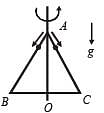JEE Exam > JEE Questions > An equilateral triangle ABC formed from a uni...
Start Learning for Free
An equilateral triangle ABC formed from a uniform wire has two small identical beads initially located at A. The triangle is set rotating about the vertical axis AO. Then the beads are released from rest simultaneously and allowed to slide down, one along AB and the other along AC as shown. Neglecting frictional effects, the quantities that are conserved as the beads slide down, are

- a)angular velocity and total energy (kinetic and potential)
- b)Total angular momentum and total energy
- c)angular velocity and moment of inertia about the axis of rotation
- d)total an gular momen tum an d moment of inertia about the axis of rotation
Correct answer is option 'B'. Can you explain this answer?
| FREE This question is part of | Download PDF Attempt this Test |
Verified Answer
An equilateral triangle ABC formed from a uniform wire has two small i...
The M.I. about the axis of rotation is not constant as the perpendicular distance of the bead with the axis of rotation increases.
Also since no external torque is acting.
Also since no external torque is acting.

Since, I increases, ω decreases.

|
Explore Courses for JEE exam
|

|
Similar JEE Doubts
An equilateral triangle ABC formed from a uniform wire has two small identical beads initially located at A. The triangle is set rotating about the vertical axis AO. Then the beads are released from rest simultaneously and allowed to slide down, one along AB and the other along AC as shown. Neglecting frictional effects, the quantities that are conserved as the beads slide down, area)angular velocity and total energy (kinetic and potential)b)Total angular momentum and total energyc)angular velocity and moment of inertia about the axis of rotationd)total an gular momen tum an d moment of inertia about the axis of rotationCorrect answer is option 'B'. Can you explain this answer?
Question Description
An equilateral triangle ABC formed from a uniform wire has two small identical beads initially located at A. The triangle is set rotating about the vertical axis AO. Then the beads are released from rest simultaneously and allowed to slide down, one along AB and the other along AC as shown. Neglecting frictional effects, the quantities that are conserved as the beads slide down, area)angular velocity and total energy (kinetic and potential)b)Total angular momentum and total energyc)angular velocity and moment of inertia about the axis of rotationd)total an gular momen tum an d moment of inertia about the axis of rotationCorrect answer is option 'B'. Can you explain this answer? for JEE 2024 is part of JEE preparation. The Question and answers have been prepared according to the JEE exam syllabus. Information about An equilateral triangle ABC formed from a uniform wire has two small identical beads initially located at A. The triangle is set rotating about the vertical axis AO. Then the beads are released from rest simultaneously and allowed to slide down, one along AB and the other along AC as shown. Neglecting frictional effects, the quantities that are conserved as the beads slide down, area)angular velocity and total energy (kinetic and potential)b)Total angular momentum and total energyc)angular velocity and moment of inertia about the axis of rotationd)total an gular momen tum an d moment of inertia about the axis of rotationCorrect answer is option 'B'. Can you explain this answer? covers all topics & solutions for JEE 2024 Exam. Find important definitions, questions, meanings, examples, exercises and tests below for An equilateral triangle ABC formed from a uniform wire has two small identical beads initially located at A. The triangle is set rotating about the vertical axis AO. Then the beads are released from rest simultaneously and allowed to slide down, one along AB and the other along AC as shown. Neglecting frictional effects, the quantities that are conserved as the beads slide down, area)angular velocity and total energy (kinetic and potential)b)Total angular momentum and total energyc)angular velocity and moment of inertia about the axis of rotationd)total an gular momen tum an d moment of inertia about the axis of rotationCorrect answer is option 'B'. Can you explain this answer?.
An equilateral triangle ABC formed from a uniform wire has two small identical beads initially located at A. The triangle is set rotating about the vertical axis AO. Then the beads are released from rest simultaneously and allowed to slide down, one along AB and the other along AC as shown. Neglecting frictional effects, the quantities that are conserved as the beads slide down, area)angular velocity and total energy (kinetic and potential)b)Total angular momentum and total energyc)angular velocity and moment of inertia about the axis of rotationd)total an gular momen tum an d moment of inertia about the axis of rotationCorrect answer is option 'B'. Can you explain this answer? for JEE 2024 is part of JEE preparation. The Question and answers have been prepared according to the JEE exam syllabus. Information about An equilateral triangle ABC formed from a uniform wire has two small identical beads initially located at A. The triangle is set rotating about the vertical axis AO. Then the beads are released from rest simultaneously and allowed to slide down, one along AB and the other along AC as shown. Neglecting frictional effects, the quantities that are conserved as the beads slide down, area)angular velocity and total energy (kinetic and potential)b)Total angular momentum and total energyc)angular velocity and moment of inertia about the axis of rotationd)total an gular momen tum an d moment of inertia about the axis of rotationCorrect answer is option 'B'. Can you explain this answer? covers all topics & solutions for JEE 2024 Exam. Find important definitions, questions, meanings, examples, exercises and tests below for An equilateral triangle ABC formed from a uniform wire has two small identical beads initially located at A. The triangle is set rotating about the vertical axis AO. Then the beads are released from rest simultaneously and allowed to slide down, one along AB and the other along AC as shown. Neglecting frictional effects, the quantities that are conserved as the beads slide down, area)angular velocity and total energy (kinetic and potential)b)Total angular momentum and total energyc)angular velocity and moment of inertia about the axis of rotationd)total an gular momen tum an d moment of inertia about the axis of rotationCorrect answer is option 'B'. Can you explain this answer?.
Solutions for An equilateral triangle ABC formed from a uniform wire has two small identical beads initially located at A. The triangle is set rotating about the vertical axis AO. Then the beads are released from rest simultaneously and allowed to slide down, one along AB and the other along AC as shown. Neglecting frictional effects, the quantities that are conserved as the beads slide down, area)angular velocity and total energy (kinetic and potential)b)Total angular momentum and total energyc)angular velocity and moment of inertia about the axis of rotationd)total an gular momen tum an d moment of inertia about the axis of rotationCorrect answer is option 'B'. Can you explain this answer? in English & in Hindi are available as part of our courses for JEE.
Download more important topics, notes, lectures and mock test series for JEE Exam by signing up for free.
Here you can find the meaning of An equilateral triangle ABC formed from a uniform wire has two small identical beads initially located at A. The triangle is set rotating about the vertical axis AO. Then the beads are released from rest simultaneously and allowed to slide down, one along AB and the other along AC as shown. Neglecting frictional effects, the quantities that are conserved as the beads slide down, area)angular velocity and total energy (kinetic and potential)b)Total angular momentum and total energyc)angular velocity and moment of inertia about the axis of rotationd)total an gular momen tum an d moment of inertia about the axis of rotationCorrect answer is option 'B'. Can you explain this answer? defined & explained in the simplest way possible. Besides giving the explanation of
An equilateral triangle ABC formed from a uniform wire has two small identical beads initially located at A. The triangle is set rotating about the vertical axis AO. Then the beads are released from rest simultaneously and allowed to slide down, one along AB and the other along AC as shown. Neglecting frictional effects, the quantities that are conserved as the beads slide down, area)angular velocity and total energy (kinetic and potential)b)Total angular momentum and total energyc)angular velocity and moment of inertia about the axis of rotationd)total an gular momen tum an d moment of inertia about the axis of rotationCorrect answer is option 'B'. Can you explain this answer?, a detailed solution for An equilateral triangle ABC formed from a uniform wire has two small identical beads initially located at A. The triangle is set rotating about the vertical axis AO. Then the beads are released from rest simultaneously and allowed to slide down, one along AB and the other along AC as shown. Neglecting frictional effects, the quantities that are conserved as the beads slide down, area)angular velocity and total energy (kinetic and potential)b)Total angular momentum and total energyc)angular velocity and moment of inertia about the axis of rotationd)total an gular momen tum an d moment of inertia about the axis of rotationCorrect answer is option 'B'. Can you explain this answer? has been provided alongside types of An equilateral triangle ABC formed from a uniform wire has two small identical beads initially located at A. The triangle is set rotating about the vertical axis AO. Then the beads are released from rest simultaneously and allowed to slide down, one along AB and the other along AC as shown. Neglecting frictional effects, the quantities that are conserved as the beads slide down, area)angular velocity and total energy (kinetic and potential)b)Total angular momentum and total energyc)angular velocity and moment of inertia about the axis of rotationd)total an gular momen tum an d moment of inertia about the axis of rotationCorrect answer is option 'B'. Can you explain this answer? theory, EduRev gives you an
ample number of questions to practice An equilateral triangle ABC formed from a uniform wire has two small identical beads initially located at A. The triangle is set rotating about the vertical axis AO. Then the beads are released from rest simultaneously and allowed to slide down, one along AB and the other along AC as shown. Neglecting frictional effects, the quantities that are conserved as the beads slide down, area)angular velocity and total energy (kinetic and potential)b)Total angular momentum and total energyc)angular velocity and moment of inertia about the axis of rotationd)total an gular momen tum an d moment of inertia about the axis of rotationCorrect answer is option 'B'. Can you explain this answer? tests, examples and also practice JEE tests.

|
Explore Courses for JEE exam
|

|
Suggested Free Tests
Signup for Free!
Signup to see your scores go up within 7 days! Learn & Practice with 1000+ FREE Notes, Videos & Tests.























